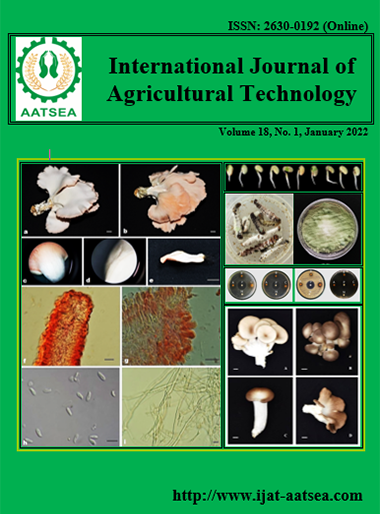Influence of age on the incidence of wooden breast and white striping, carcass composition, meat physicochemical property, texture profile, and chemical composition of broiler chickens
Main Article Content
Abstract
The effects of the age at 43 and 51 days on the incidence of wooden breast (WB) and white striping (WS), carcass composition, meat physicochemical property, textural profile, and chemical composition of broiler chickens were investigated. The frequency and percentage of WB and severity of WS did not differ between age groups. Live weight and carcass weight were affected by age, except the carcass composition percentages. Breast, thigh, wing, and leg weights were not differences between groups. However, the percentage of the thigh was higher in broilers at 51 days of age than at 43 days of age. The percentage of meat physicochemical properties; pH3 and pH24 of broilers at 43 days of age were higher than those at 51 days of age (P<0.01). Broiler meat at 51 days of age had statistically significant higher a* value, while L*, b*, chroma, and hue values were not significant differences. There were not significant differences in drip loss percentage, cooking loss percentage, and shear force value. Hardness, gumminess, and chewiness were higher in 51-day-old broilers than 43-day-old broilers (P<0.05), except the cohesiveness of cooked meat of 51-day-old broilers was higher than that of 43-day-old broilers (P>0.05). For meat chemical composition, the different age groups did not affect the chemical composition, but only the percentage fat content of 51-day-old broilers tended to be higher than that of 43-day-old broilers
Article Details

This work is licensed under a Creative Commons Attribution-NonCommercial-NoDerivatives 4.0 International License.
References
AOAC International (2000). Official Methods of Analysis of AOAC International. 17th ed. (Horwitz, W. ed.)
Baéza, E., Arnould, C., Jlali, M., Chartrin, P., Gigaud, V., Mercerand, F., Durand, C., Méteau, K., Le Bihan-Duval, E. and Berri, C. (2012). Influence of increasing slaughter age of chickens on meat quality, welfare, and technical and economic results. Journal of Animal Science, 90:2003-2013.
Coban, O., Lacin, E., Aksu, M. I., Kara, A. and Sabuncouglu, N. (2014). The impact of slaughter age on performance, carcass traits, properties of cut-up pieces of carcasses, and muscle development in broiler chickens. European Poultry Science, 78:1612-9199.
FAO (2019). Food Outlook – Biannual Report on Global Food Markets. Rome: CC BY-NC-SA 3.0 IGO.
Ferreira, T. Z., Casagrande, R. A., Vieira, S. L., Driemeier, D. and Kindlein, L. (2014). An investigation of a reported case of white striping in broilers. Journal of Applied Poultry Research, 23:748-753.
Glamoclija, N., Starcevic, M., Janjic, J., Ivanovic, J., Boskovic, M., Djordjevic, J., Markovic, R. and Baltic, M. Z. (2015). The effect of breed line and age on measurements of pH-value as meat quality parameter in breast muscles (m. pectoralis major) of broiler chickens. Procedia Food Science, 5:89-92.
Kurnoth, T., Salomon, F. and Gille, U. (1994). Quantitative changes in the capillary supply of selected muscles of turkeys, ducks, rats and swine during postnatal development. Anatomia Histologia Embryologia, 23:21-39.
Kuttappan, V. A., Brewer, V. B., Mauromoustakos, A., McKee, S. R., Emmert, J. L., Meullenet, J. F. and Owens, C. M. (2013). Estimation of factors associated with the occurrence of white striping in broiler breast fillets. Poultry Science, 92:811-819.
Lyon, C. E., Hamm, D., Hudspeth, J. P. and Benoff, F. H. (1984). Effects of age and sex on the texture profile of hot stripped broiler breast meat. Poultry Science, 63:2508-2510.
Malila, Y., U-chupaj, J., Srimarut, Y., Chaiwiwattrakul, P., Uengwetwanit, T., Arayamethakorn, S., Punyapornwithaya, V., Sansamur, C., Kirschke, C. P., Huang, L., Tepaamorndech, S., Petracci, M., Rungrassamee, W. and Visessanguan, W. (2018). Monitoring of white striping and wooden breast cases and impacts on quality of breast meat collected from commercial broilers (Gallus gallus). Asian-Australasian Journal of Animal Sciences 13, 11:1807-1817.
Mir, N. A., Rafiq, A., Faneshwar, K., Singh, V. and Shukla, V. (2017). Determinants of broiler chicken meat quality and factors affecting them: a review. Journal of Food Science and Technology, 54:2997-3009.
National Chicken Council (2015). Statistics and research: U.S. Broiler Performance. Retrieved from http://www.nationalchickencouncil.org/ about-theindustry/statistics/u-s-broiler- performance/
Papinaho, P. A., Ruusunen, M. H., Suuronen, T. and Fletcher, D. L. (1996). Relationship between Mmuscle biochemical and meat quality properties of early deboned broiler breasts. Journal of Applied Poultry Research, 5:126-133.
Radaelli, G., Piccirillo, A., Birolo, M., Bertotto, D., Gratta, F., Ballarin, C., Vascellari, M., Xiccato, G. and Trocino, A. (2017). Effect of age on the occurrence of muscle fiber degeneration associated with myopathies in broiler chickens submitted to feed restriction. Poultry Science, 96:309-319.
Sihvo, H. K., Lindén, J., Airas, N., Immonen, K., Valaja, J. and Puolanne, E. (2017). Wooden breast myodegeneration of pectoralis major muscle over the growth period in broilers. Veterinary Pathology, 51:619–623.
Trocino, A., Piccirillo, A., Birolo, M., Radaelli, G., Bertotto, D., Filiou, E., Petracci, M. and Xiccato, G. (2015). Effect of genotype, gender and feed restriction on growth, meat quality and the occurrence of white striping and woody breast in broiler chickens. Poultry Science, 94:2996-3004.
USDA (2018). Food Data Central: Chicken, breolers or fryers, breast, meat only, cooked, roasted. Retrieved from https://fdc.nal.usda.gov/fdc-app.html#/fooddetails/171477/nutrients
Young, L. L., Northcutt, J. K., Buhr, R. J., Lyon, C. E. and Ware, G. O. (2001). Effects of age, sex, and duration of postmortem aging on percentage yield of parts from broiler chicken carcasses. Poultry Science, 80:376-379.


